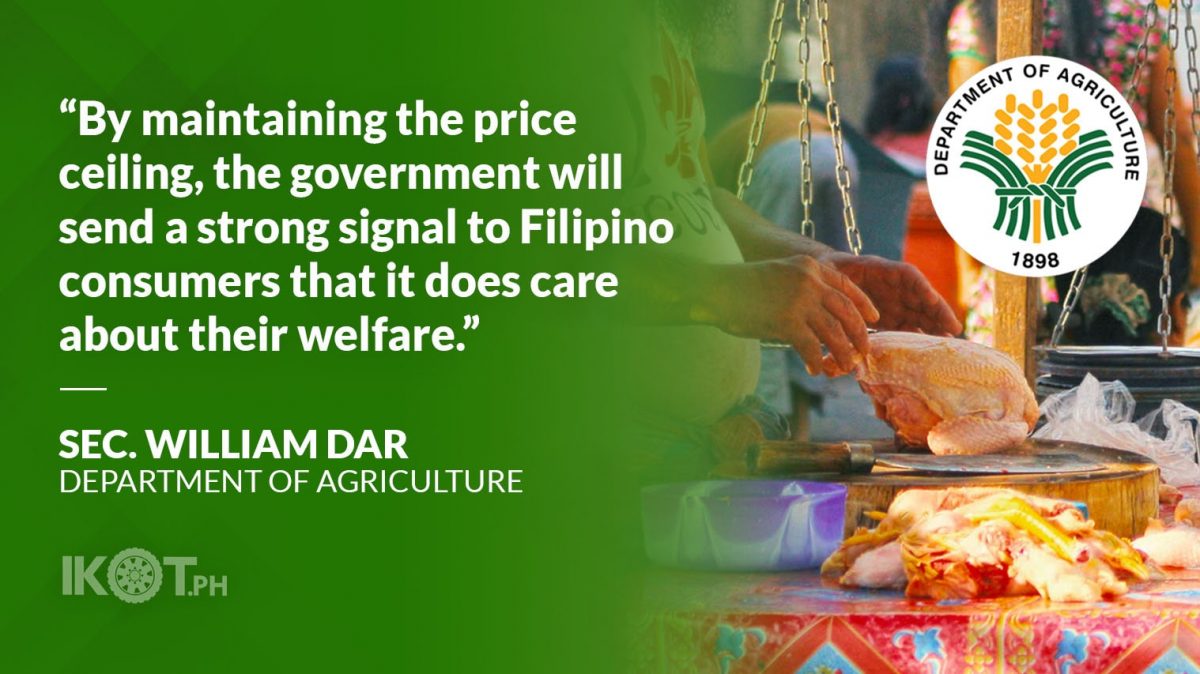The price ceiling on pork and chicken stays, as it has undeniably contributed to taming the price surge of said two main food items, benefiting millions of Filipino consumers, particularly in Metro Manila, said Agriculture Secretary William Dar.
“We will maintain it in the remaining days until April 8, as prescribed under EO 124,” Dar stressed.
“Lifting it will undeniably result in a dramatic rise in prices of pork and chicken, given that the ASF crisis is still raging.”
“Lifting it will undeniably result in a dramatic rise in prices of pork and chicken, given that the African swine fever (ASF) crisis is still raging and thus continues to impact on local production of hogs nationwide,” the agriculture chief noted.
“That is why we need to augment the current shortfall, estimated at 400,000 metric tons this year, from ASF-free countries,” the agriculture head added.
As the inflation rate again rose in February at 4.7 percent (versus 4.2 percent in January), he said it is incumbent upon the Duterte government to take all necessary measures to check inflationary pressure to protect low-income households, particularly the poor, who are hurt most — because high inflation further fritters away the value of their already small income.
Further, on the suggestion of hog raisers to raise the price ceiling, Dar said it would be a redundant measure given that the actual average pork and chicken prices are higher than the ceiling imposed by EO 124.
He added that it is not far-fetched that if the price ceiling is raised to a new level, industry players will hike their prices once again, emboldened by the knowledge that they are capable of pressuring the government to change its mind.
In the meantime, consumers will be fretting that the government is not really serious in protecting their interests, Dar said.
“The price ceiling is still an effective deterrent against unscrupulous trading activities.”
“Though the price ceiling may not ensure full compliance by the traders and retailers, it is still an effective deterrent against unscrupulous trading activities,” he stressed.
EO 124 will lapse on April 8, barely a month from now.
“By maintaining it, the government will send a strong signal to Filipino consumers — who suffer from lower incomes due to the adverse impact of the COVID-19 pandemic on our economy — that it does care about their welfare,” Dar said.
“Hog producers, wholesalers, and retailers are no less expected to do their share in helping the country’s economic recovery effort,” he added.
The latest report gathered by the DA field operations service (FOS) indicates that the total hog and carcass deliveries from various regions to Metro Manila, from February 8 to March 7, 2021, have reached 127,868 heads, and 823,673 kilograms (kg) of carcass, for an average of 4,567 heads and 28,417 kg daily.
These surpass Metro Manila’s average daily requirement of 4,000 heads.
The number of hogs transported to Metro Manila has been stable, from February 8 to March 7, said DA assistant secretary Arnel de Mesa of the DA-FOS in his report to secretary Dar.
De Mesa said the hog and carcass deliveries to Metro Manila public markets peak every Wednesday, coming from regions Calabarzon (Cavite, Laguna Batangas, Rizal, and Quezon), Mimaropa (Mindoro, Marinduque, Romblon, and Palawan), Western Visayas, Soccsksargen, and Northern Mindanao.

